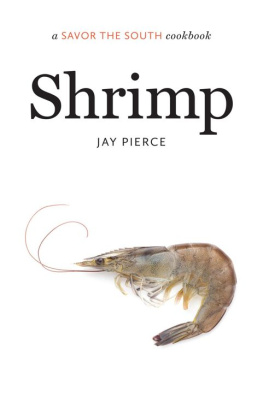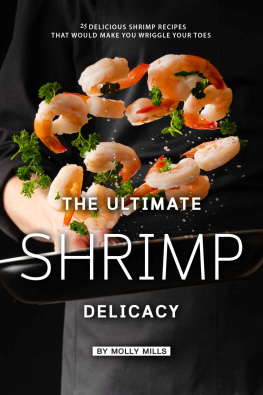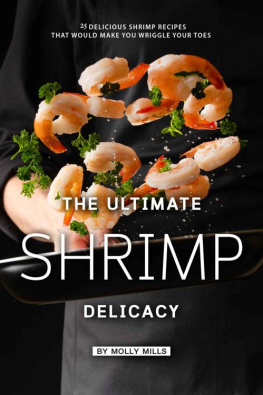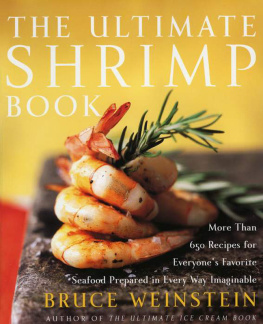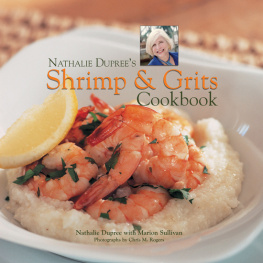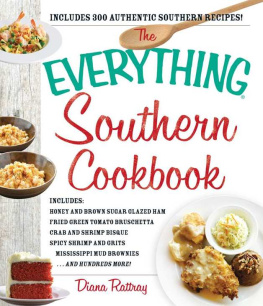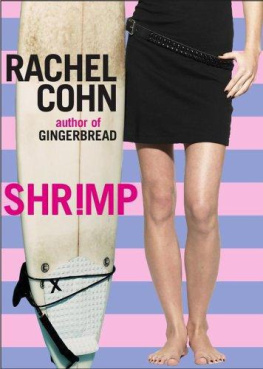Contents
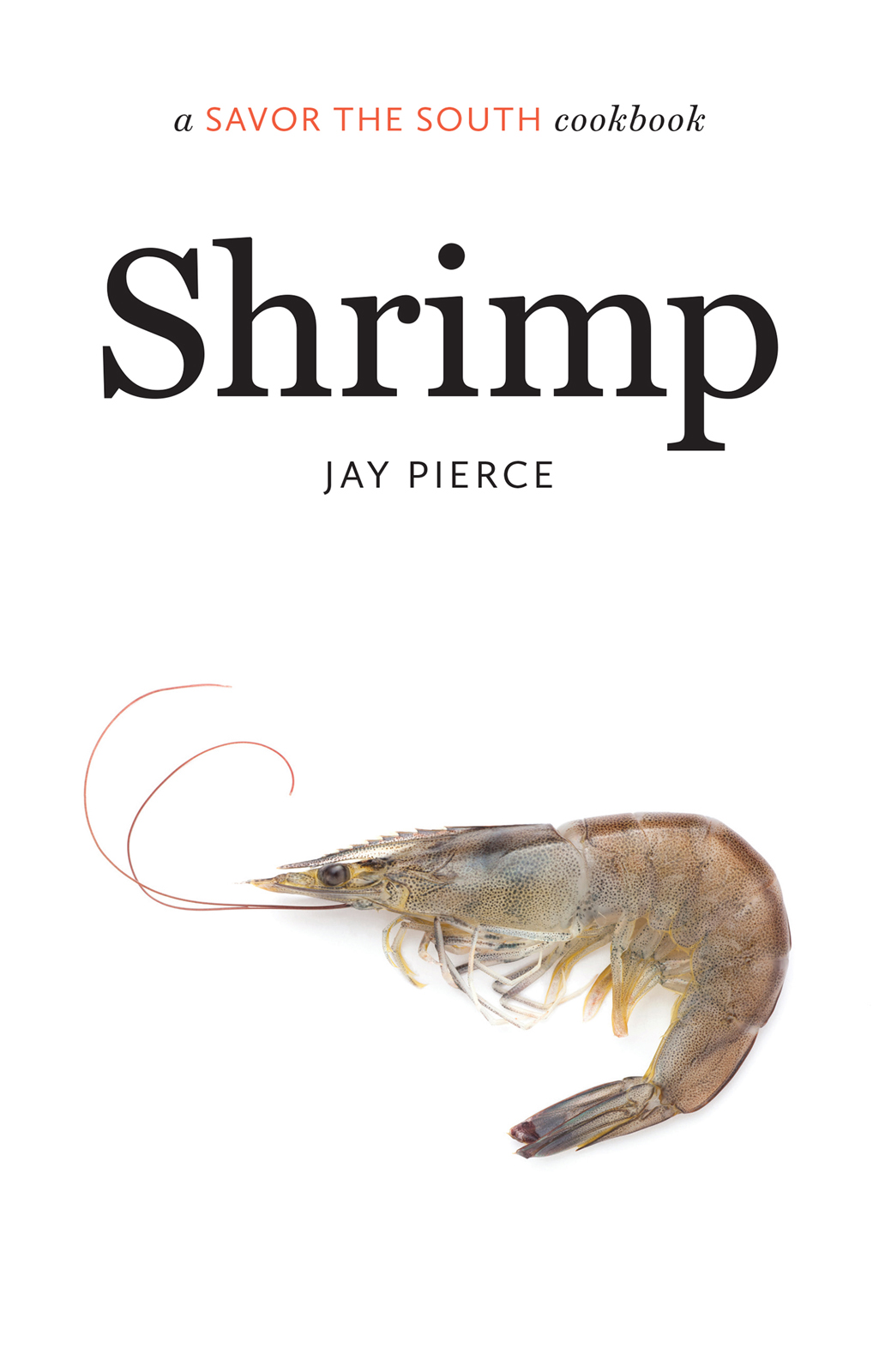
a SAVOR THE SOUTH cookbook
Shrimp
SAVOR THE SOUTH cookbooks
Shrimp, by Jay Pierce (2015)
Catfish, by Paul and Angela Knipple (2015)
Gumbo, by Dale Curry (2015)
Sweet Potatoes, by April McGreger (2014)
Southern Holidays, by Debbie Moose (2014)
Okra, by Virginia Willis (2014)
Pickles and Preserves, by Andrea Weigl (2014)
Bourbon, by Kathleen Purvis (2013)
Biscuits, by Belinda Ellis (2013)
Tomatoes, by Miriam Rubin (2013)
Peaches, by Kelly Alexander (2013)
Pecans, by Kathleen Purvis (2012)
Buttermilk, by Debbie Moose (2012)
2015 The University of North Carolina Press
All rights reserved. Manufactured in the United States of America
SAVOR THE SOUTH is a registered trademark of the
University of North Carolina Press, Inc.
Designed by Kimberly Bryant and set in Miller and
Calluna Sans types by Rebecca Evans.
The paper in this book meets the guidelines for permanence and durability of the Committee on Production Guidelines for Book Longevity of the Council on Library Resources. The University of North Carolina Press has been a member of the Green Press Initiative since 2003.
Jacket illustration: depositphotos.com/ koosen
Library of Congress Cataloging-in-Publication Data
Pierce, Jay (Chef)
Shrimp / by Jay Pierce.
pages cm.(Savor the South cookbooks)
Includes index.
ISBN 978-1-4696-2114-2 (cloth : alk. paper)
ISBN 978-1-4696-2115-9 (ebook)
1. Cooking (Shrimp) 2. Cooking, AmericanSouthern style. I. Title.
TX 754.S58P54 2015 641.695dc23
2014023109
19 18 17 16 15 5 4 3 2 1
New OrleansStyle Barbecue Shrimp in South Carolina; Tom Yum Goong, a Thai Shrimp Soup; and Buttered Brown Rice with Shrimp, Duck Cracklings, and Roasted Mushrooms are based on recipes in Joe and Heidi Trull, Grits and Groceries: Real Food Done Real Good (Belton, S.C., 2007); Nancie McDermott, Real Thai: The Best of Thailands Regional Cooking (San Francisco: Chronicle Books, 1992); and Gabrielle Hamilton, Prune (New York: Random House, forthcoming), respectively.
Contents
a SAVOR THE SOUTH cookbook
Shrimp
INTRODUCTION
SHRIMP MATTERS
Enjoyed equally at the finest white-tablecloth celebrations and when eaten with bare hands in sun-drenched locales, shrimp have an unending versatility that may very well make them the perfect food. The most consumed seafood in America, shrimp can be found on menus coast to coast, but southerners enjoy a special relationship with shrimp dishes. Whether due to our proximity to shrimp-abundant waters or the tremendous influence of our French, Spanish, and African forebears on our foodways, a truly southern menu isnt complete without a beloved shrimp dish.
From seersucker suits to chess pies, from whole hog cookery to SEC football, the South is in style. A paramount southern delicacy, shrimp are eaten with gusto in coastal communities and at potlucks and other gatherings to celebrate family reunions, engagements, weddings, christenings, and wakes. Shrimp cookery is easy to learn, and shrimp can be seasoned to suit a wide range of tastes. A lean protein thats mildly sweet, these tasty crustaceans can be incorporated into almost any dish, from enchiladas to spaghetti, poboys to ceviche, Thai curry to bloody marys. And how can you beat entertaining a crowd with a pure and simple shrimp boil? While these crustaceans are still ubiquitous throughout the country in the uninspired shrimp cocktails of generic hotel restaurants or the fried shrimp baskets of fast-food outlets, southern chefs and home cooks alike have embraced the myriad ways that shrimp can be brought to the table. The past decade has seen numerous interesting incarnations of shrimp and grits, showcasing that southern triumvirate of pork, seafood, and grits and paying tribute to the local crustaceans in a way that elevates shrimp above all other seafood. Whereas crawfish can be an acquired taste beyond South Louisiana and crabs require a lot of work to yield those succulent hunks of meat, shrimp are approachable, easy to manipulate, and just plain delectable. And shrimp are downright irreplaceable in the South. Seafood gumbo wouldnt be a quintessential southern dish if it didnt include shrimpcrab stock provides the backbone, but shrimp provide the sex appeal that beckons you hither.
Is there a more delightful taste surprise than the one you get when sitting at a newspaper-covered picnic table in someones backyard with the sun shining through your heavily tinted sunglasses; the air thick with humidity; a sweating, icy-cold beer in your hand; and the tender flesh of a shrimp giving way with a pop between your teeth? Your anticipation transports you to a timeless place where you commune with your ancestors, who also participated in this ritual for years untold. The wafting aromas of cayenne pepper, garlic, and brine make your heart race. Between the spicy andouille sausage, the Silver Queen corn, and the mounds of colorful crustaceans, your senses are overwhelmed. Your fingers and lips burn from the heat and the spice, and the only thing that limits your intake is how fast you can peel.
But What Do I Know?
Growing up on the Louisiana Gulf Coast, I had many occasions to catch, sort, buy, dehead, peel, freeze, thaw, devein, and cook shrimp, from brown shrimp in May to white shrimp in August. Every family that I knew growing up had enough bags of shrimp in the freezer to last until the next shrimp season. Prior to the invention of resealable freezer bags, repurposed margarine containers were employed, which had in turn replaced half-gallon wax milk cartons; folks would peel apart the back of the spout to form a square opening at the top of the carton. Every family knew more than a community-cookbookful of ways to prepare its Gulf shrimpway more than just fried shrimp and shrimp cocktail.
When I was a kid, sometimes my dad would take me trawling for shrimp. I remember having to get up so early that it still felt like it was the night before. The goal was to pack everything before we went to sleep, wake up, make sandwiches (ham and American cheese with Blue Plate mayonnaise), drive down to Myrtle Grove (about thirty minutes away), and be in the boat and on the water before the sun came up. When picturing shrimpers at work, most folks think of commercial fishing vessels with their huge butterfly nets on outriggers hoisted into the sky, but recreational trawlers that work inland waterways are a bit different. We would set out in a twenty-foot boat with a sixteen-foot-long funnel-shaped net, wide at the stern of the boat and tapering to a narrow opening that was tied closed. The mouth of the net was attached to empty milk jugs or floats at the top and weighted at the bottom with a chain. The net was held open as the boat moved slowly through the water by the hydrodynamic force on the metal-reinforced oak boards that flanked the opening. Everything in the boats path that couldnt swim fast enough to get out of the way was consumed by the maw of this net. Another float was affixed to the trailing end of the net (referred to as the ball when full). I didnt know it then, but this type of net is known as an otter trawl, and its adoption by shrimpers in the early twentieth century had a profound impact on the commercial shrimping industry in the South.
In the boat, my dad would attempt to aim the boat where the shrimp might be, cutting the wheel back and forth so we would proceed in a serpentine pattern. We would always hope to find a jubilee, which is when the shrimp are at the surface of the water, feeding and splashing and just asking to be caught. From the dock, we would motor down Wilkinson Canal to get to Little Lake or Lake Salvador or whichever body of water we wanted to try that Saturday morning. My dad would make a pass for about an hour or so and then pull in the lazy line to bring the ball closer to the boat to see if we were catching anything. If the ball had more shrimp than mud, hed kill the engine and wed pull in the lines to collect the net. On a good day when the net was full, this would be a chore. After the whole net was pulled into the boat, the ball was placed in the picking box and opened. All manner of creatures would spill out into that plywood trough arranged across the gunwales. Next would come my primary responsibility: sorting through the catch, throwing overboard the small fish, sticks, mud clods, jellyfish, and other undesirable bycatch. We would usually score some flounder or other bottom-dwelling fish, and we would always get crabs, which would go into a separate hamper. Once the catch was reduced to just shrimp, we would place them in ice chests. Meanwhile, my dad would be dragging the net again as I was picking, and if we were in the right place at the right time, it would be time to haul in the net by the time I was done in the picking box. This would go on for a few hours until we would stop to eat our sandwiches, then we would take the boat into dock and drive home with our catch. We would get home around noon, smelly and tired, but our work for the day wasnt done yet. We still had to sort the shrimp, pop the heads off, and freeze them. We would sell some to neighbors and have some for dinner that night. Our freezer would be packed with enough shrimp to eat weekly for the next six months or so.


